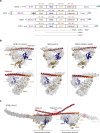The DBHS proteins SFPQ, NONO and PSPC1: a multipurpose molecular scaffold
- PMID: 27084935
- PMCID: PMC4872119
- DOI: 10.1093/nar/gkw271
The DBHS proteins SFPQ, NONO and PSPC1: a multipurpose molecular scaffold
Abstract
Nuclear proteins are often given a concise title that captures their function, such as 'transcription factor,' 'polymerase' or 'nuclear-receptor.' However, for members of the Drosophila behavior/human splicing (DBHS) protein family, no such clean-cut title exists. DBHS proteins are frequently identified engaging in almost every step of gene regulation, including but not limited to, transcriptional regulation, RNA processing and transport, and DNA repair. Herein, we present a coherent picture of DBHS proteins, integrating recent structural insights on dimerization, nucleic acid binding modalities and oligomerization propensity with biological function. The emerging paradigm describes a family of dynamic proteins mediating a wide range of protein-protein and protein-nucleic acid interactions, on the whole acting as a multipurpose molecular scaffold. Overall, significant steps toward appreciating the role of DBHS proteins have been made, but we are only beginning to understand the complexity and broader importance of this family in cellular biology.
© The Author(s) 2016. Published by Oxford University Press on behalf of Nucleic Acids Research.
Figures




References
-
- Shav-Tal Y., Zipori D. PSF and p54(nrb)/NonO - multi-functional nuclear proteins. FEBS Lett. 2002;531:109–114. - PubMed
MeSH terms
Substances
LinkOut - more resources
Full Text Sources
Other Literature Sources
Molecular Biology Databases
Miscellaneous

